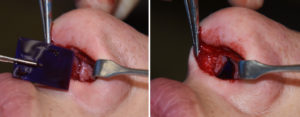Rhinoplasty is a general term that typically refers to external nose reshaping. But it is not uncommon that the very patient that has a desire to change the shape of their nose also has breathing difficulties due to internal structural issues. While most people think of nose breathing issues due to a septal deviation, other internal nasal structures such as the inferior turbinates may be involved as well.
When external nose reshaping and internal breathing difficulty surgeries are combined the proper term is a septorhinoplasty. In reality even if the nasals septum is not being straightened, it is still being used for a cartilage harvest site to provide the necessary materials for reshaping and supporting the external nose shape changes.
In the treatment of the deviated or crooked nose, a septorhinoplasty is a must as part of the problem is a septum that is not straight. Correcting the septal deviation as much as possible is a critical element in this surgery. Often the patient presents from having a prior surgery and/or cartilage graft harvest, making the native septal support weak. It becomes very difficult to straighten a septum when it is structurally weak since a central strong support is needed.

The PDS plate is made of polydioxanone, a well known polymer used in sutures that has an established resorption profile. It can take more than six months for the plate to resorb which is enough time for the cartilage to heal in its new position.
Dr. Barry Eppley
Indianapolis, Indiana


